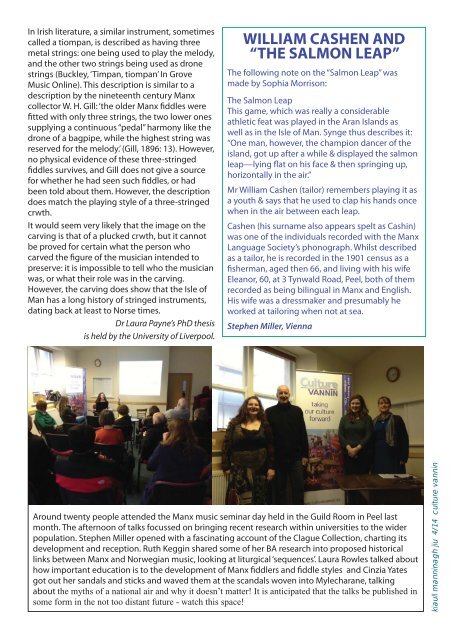You also want an ePaper? Increase the reach of your titles
YUMPU automatically turns print PDFs into web optimized ePapers that Google loves.
In Irish literature, a similar instrument, sometimescalled a tiompan, is described as having threemetal strings: one being used to play the melody,and the other two strings being used as dronestrings (Buckley, ‘Timpan, tiompan’ In GroveMusic Online). This description is similar to adescription by the nineteenth century Manxcollector W. H. Gill: ‘the older Manx fiddles werefitted with only three strings, the two lower onessupplying a continuous “pedal” harmony like thedrone of a bagpipe, while the highest string wasreserved for the melody.’ (Gill, 1896: 13). However,no physical evidence of these three-stringedfiddles survives, and Gill does not give a sourcefor whether he had seen such fiddles, or hadbeen told about them. However, the descriptiondoes match the playing style of a three-stringedcrwth.It would seem very likely that the image on thecarving is that of a plucked crwth, but it cannotbe proved for certain what the person whocarved the figure of the musician intended topreserve: it is impossible to tell who the musicianwas, or what their role was in the carving.However, the carving does show that the Isle ofMan has a long history of stringed instruments,dating back at least to Norse times.Dr Laura Payne’s PhD thesisis held by the University of Liverpool.WILLIAM CASHEN AND“THE SALMON LEAP”The following note on the “Salmon Leap” wasmade by Sophia Morrison:The Salmon LeapThis game, which was really a considerableathletic feat was played in the Aran Islands aswell as in the Isle of Man. Synge thus describes it:“One man, however, the champion dancer of theisland, got up after a while & displayed the salmonleap—lying flat on his face & then springing up,horizontally in the air.”Mr William Cashen (tailor) remembers playing it asa youth & says that he used to clap his hands oncewhen in the air between each leap.Cashen (his surname also appears spelt as Cashin)was one of the individuals recorded with the ManxLanguage Society’s phonograph. Whilst describedas a tailor, he is recorded in the 1901 census as afisherman, aged then 66, and living with his wifeEleanor, 60, at 3 Tynwald Road, Peel, both of themrecorded as being bilingual in Manx and English.His wife was a dressmaker and presumably heworked at tailoring when not at sea.Stephen Miller, ViennaAround twenty people attended the Manx music seminar day held in the Guild Room in Peel lastmonth. The afternoon of talks focussed on bringing recent research within universities to the widerpopulation. Stephen Miller opened with a fascinating account of the Clague Collection, charting itsdevelopment and reception. Ruth Keggin shared some of her BA research into proposed historicallinks between Manx and Norwegian music, looking at liturgical ‘sequences’. Laura Rowles talked abouthow important education is to the development of Manx fiddlers and fiddle styles and Cinzia Yatesgot out her sandals and sticks and waved them at the scandals woven into Mylecharane, talkingabout the myths of a national air and why it doesn’t matter! It is anticipated that the talks be published insome form in the not too distant future - watch this space!kiaull manninagh jiu 4/14 culture vannin


